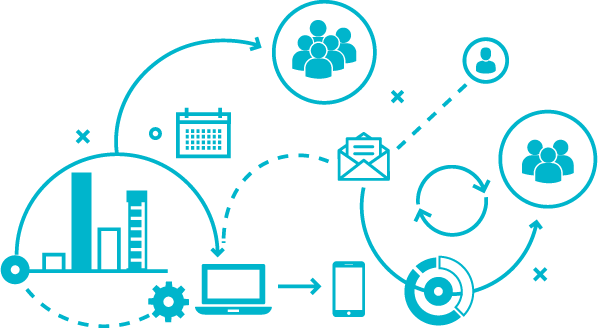What is digital communication?
Digital communication is any communication that relies on the use of technology. There are many digital communication types, commonly called digital communication channels. These include email, phone calls, video conferencing, and many types of instant messaging like SMS and web chats. Even blogs, podcasts, and videos are considered forms of digital communication.
Lumen identifies five defining characteristics that set digital communication apart from traditional communication methods. According to their analysis, digital communication is:
- More interactive
- More participatory
- More egalitarian
- More decentralized
- Less hierarchical
These qualities mean that any communication taking place through digital channels will be inherently different from in-person communication. In the workplace, these differences present themselves as both advantages and disadvantages.
Advantages of digital communication in the workplace
Digital communication is fast, efficient, and convenient. An employee can have a conversation in real time with a colleague or client from the opposite side of the world without leaving their desk. Company leaders can use digital channels to communicate with their entire global workforce at once and use corresponding channels to collect feedback from those employees effectively. It’s key to employee engagement.
Most modern marketing initiatives can be viewed as digital communication. Social media campaigns and video ads are simply a way for companies to mass communicate with potential customers in a way that is rapid and cost-effective.
Looking at all the business areas involving digital communication, it’s safe to say that modern technology has vastly improved how companies operate. With easy and accessible communication systems, employees can focus on more important tasks.
Disadvantages of digital communication in the workplace
As the business world embraces digital communication, a few disadvantages have emerged. For one, having constant access to communication tools can impact digital wellbeing and make it hard for employees to disconnect at the end of the workday. Email notifications and pings from work apps follow them home through their smartphone, blurring the line between work and personal life. Without having a chance to unplug, employees are more likely to experience burnout and other signs of overworking themselves.
Digital communication has also presented security challenges for many companies. Hackers can make their way into virtual meetings and hijack the call; email phishing opens a door for the entire organization’s online systems to be compromised. Every time company data is transmitted over the internet, there is a risk that this information won’t remain private.
How is workplace communication changing in the digital age?
Workplace communication is undergoing a profound transformation in the rapidly evolving digital landscape. Traditional modes of interaction have shifted towards a dynamic realm of digital tools and platforms. Teams now collaborate seamlessly across geographical boundaries, leveraging instant messaging, video conferencing, and project management tools. This shift has enabled real-time connectivity, fostering a culture of remote work and flexible schedules. Moreover, the rise of social media and internal communication platforms has democratized information flow, allowing for quicker dissemination of updates and fostering a more transparent work environment. As technology continues to advance, the trajectory of workplace communication in the digital age remains an ever-evolving landscape, shaping the way we collaborate and connect.
In the digital age, what are the challenges of digital communication in the workplace?
While the digital age has revolutionized workplace communication, it presents unique challenges.
- Information Overload: Numerous communication channels can lead to difficulty in managing messages, resulting in distractions and reduced productivity.
- Misinterpretation in Communication: Absence of non-verbal cues may cause misunderstandings or conflicts due to misinterpreting tone and intent in digital communication.
- Security and Privacy Concerns: Sensitive data transmitted digitally faces vulnerability to cyber threats, raising significant security and privacy concerns.
- Constant Adaptation to Technology: The continuous evolution of new technologies and platforms poses a challenge, potentially creating a digital divide within the workforce.
- Strategic Approach Needed: Addressing these challenges requires a strategic approach emphasizing clarity and security and fostering a culture that embraces the evolving nature of digital tools in the workplace.
The dos and don’ts of digital communication in the workplace
When addressing the use of digital communication in your organization, there are a few habits you should stick to – and some to avoid:
DO use different digital channels.
There is a vast diversity of available digital communication channels for a reason. In the 21st century, the days of sending everything over email have long passed. Chats, video conferencing, and project collaboration tools are all examples of great assets for your company. Of course, each channel should have a unique goal and purpose. You don’t want to add digital communication tools simply for the sake of having them.
DON’T overload your employees with notifications.
According to CMSWire, 75% of employees feel that they waste time every day staying on top of notifications, and 66% even say the time wasted is greater than 30 minutes. Employees should stay in control of how and when they receive work-related communications, and urgent notifications should be reserved for only the most time-sensitive information.
DO tailor your message.
As there are many different digital communication channels, each channel is best for delivering certain types of information. Workplace chats, for example, are great for quick questions and clarifications. If the subject you’re addressing requires a lengthy discussion, it’s best to schedule a meeting instead.
You may also need to address multiple teams or nationalities with the same message. In this case, think about whether your message should be tweaked for different groups. For example, a multinational organization might need to send translated letters from the president to offices in different geographical locations. A virtual seminar could be improved by including specific information for different teams, like operations and sales. Thankfully, digital communication tools make it easy to achieve all of this.
DON’T forgo training.
Digital communication tools aren’t always easy to learn how to use, and you’ll find that some employees take longer to adapt than others due to varying levels of digital dexterity. This can be overcome with adequate training for each new tool, considering the different skill levels that exist across the organization. On the other hand, a lack of training will cause some employees to avoid using the tools they don’t understand.
DO encourage social sharing.
It should be easy for employees to share communications with each other and, where appropriate, with their wider network. Make the most of your digital communications tool by creating an employee advocacy program. By turning the staff into brand ambassadors, employee advocacy initiatives help motivate employees to get involved. Employee advocacy marketing is also an underused tool for improving organic reach.
DON’T underestimate the power of a company-wide policy.
When it comes to digital communication, employees look to company leadership for instructions on how, when, and where to use different tools. With a company-wide digital communication policy, you’ll have better control over usage and privacy relating to your various communication channels.
In the digital age, how do you create a digital communications policy for your company?
Digital communication policies are commonplace across companies of all sizes. These policies have many benefits, including better security, improved efficiency, and reduced shadow IT. There are a few factors that should go into your digital communication policy to maximize its effectiveness.
Establish governance
The first step in outlining a digital communication policy is to determine governance. This will specify who is responsible for decision-making and oversight of various channels, in addition to creating guidelines for naming, organizing, and archiving content. The stakeholders identified in your governance policy should be responsible for creating other digital communication policies and updating them as needed.
Dictate security protocol
How will your company manage security across its digital channels? Employees need to know what restrictions are in place, including which devices they can use to access work materials, which types of sensitive information shouldn’t be sent digitally, and which digital tools they are authorized to use as part of their workflow. The policy should also communicate any potential consequences employees may face for failing to follow security measures.
Define channels
Each digital communication channel has its unique purpose. To make these purposes clear, a digital communication policy can define when, how, and why each channel should be used. This will help organize and prioritize different types of communication, ensuring the best possible experience for everyone involved.
Set standards for responsiveness
As we’ve discussed, staying constantly plugged in is bad for burnout. That said, it’s still important for employees to check and respond to communications regularly. Your digital communication policy can set the standard for how frequently employees are expected to check their email, read company-wide bulletins, and answer instant messages. With those time frames in mind, employees won’t feel pressured to respond right away if they’re at home or in the middle of a more urgent task.
Essential digital communication tools for the workplace
Now that you know how to effectively use digital communication tools, which are the most important for your organization? The answer is different for every company but typically includes the following:
- Email client with built-in features
- Chat/instant messaging
- Project-based collaboration tool
- Video conferencing
- Internal blog from the CEO or president
- Corporate news channel
- Discussion forum
Pro tip: Powell Intranet is an all-in-one digital workplace solution containing every digital communication tool your company needs for success.



